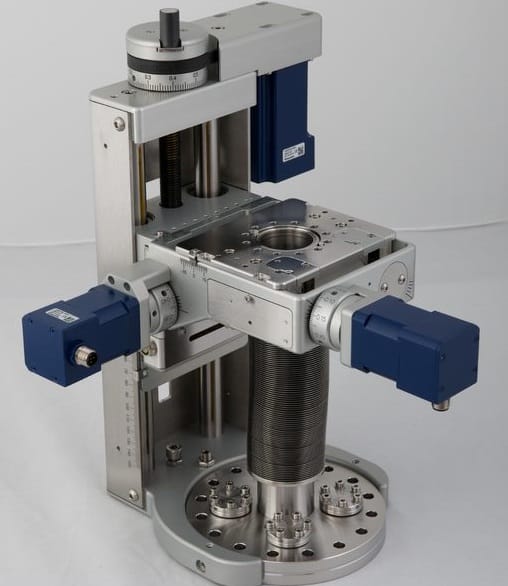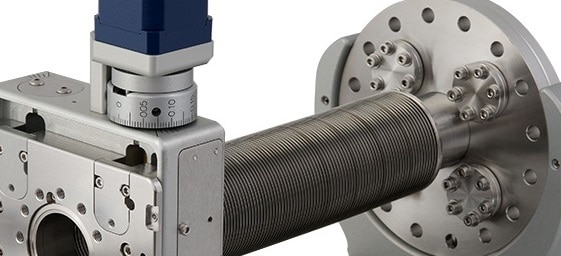Design evolution yields streamlined positioning platform for ultrahigh vacuum
19 Feb 2019 Sponsored by UHV Design
The TETRAXE manipulator combines high precision with a more compact footprint (Courtesy: UHV Design)
Manipulator stages are critical components for ultrahigh vacuum (UHV) experiments, providing precise control over the position of the sample for improved measurement accuracy. Coupled with a suitable probe, such positioners can be used, for example, to bring features into focus during high-resolution imaging or to gather chemical and structural data from different surface areas on a sample. Positioning units can be found not just on standalone systems in the lab, but also at synchrotron facilities supporting a raft of end-station instruments.
Conventional solutions involve a coupled arrangement of cross-roller slides and micrometers, but UK-based company UHV Design knew it could squeeze more out of the concept by applying a combination of production experience, design flair and simulation expertise. “We looked at all of the features that would improve the user experience,” explains Jonty Eyres, director of engineering at UHV Design.
The result of this design innovation is firm’s latest generation of sample positioners, dubbed TETRAXE, which combines high precision with a small footprint – which is essential for use with vacuum chambers that are typically crowded with other equipment.
Available in both manual and motorized versions, the TETRAXE range exploits new thinking on actuation design. The unit’s XYZT micrometers, which provide precise linear motion along their respective axes along with a tilt feature to correct for any slight misalignments in the host vacuum chamber, are now embedded into the body of the positioning stage.
Compact footprint, flexible use
Embedding the micrometers into the positioning stage makes the platform more compact, but offers other advantages too. One is that the embedded micrometer assembly can withstand bake-out at 250 ºC, which simplifies the overall installation process. This feature also applies to the limit switches, which are part of the motorized package. Only the motors and connecting wires, which are quick and easy to reconnect, need to be unscrewed or unplugged.
“We developed bakeable printed circuit boards to avoid the situation where a user, who would ordinarily have to remove limit switches for bake-out, finds that one of the end-stops has moved during the process and needs to be readjusted,” says Eyres. “It’s a unique feature of the design and makes setup much easier.” The TETRAXE manipulator is available in manual and motorized versions (Courtesy: UHV Design)
The TETRAXE manipulator is available in manual and motorized versions (Courtesy: UHV Design)
 The TETRAXE manipulator is available in manual and motorized versions (Courtesy: UHV Design)
The TETRAXE manipulator is available in manual and motorized versions (Courtesy: UHV Design)
Ease of setup and configuration are also addressed with a choice of left- or right-hand mounts for manual/motorized drives, which are swappable for each axis of motion. “It gives customers more options – for example, when they have a view port next to the mounting site on the vacuum chamber and need to keep that area clear,” says Lukasz Rybacki, a product designer at the firm, who’s played a key role in TETRAXE’s evolution. “The new micrometer design also helps if users want to upgrade from a manual to a motorized drive, as we can provide a kit.”
There are more choices too when it comes to bolting the XYZT positioner to the vacuum chamber, thanks to the option of flanges with either straddled or in-line mounting holes. Again, it’s a design feature that could make all the difference when the ability to slightly re-orientate the unit avoids a clash with neighbouring equipment outside the chamber.
Another important consideration for clients is the stability of the manipulator – particularly in high-resolution imaging applications, where vibration and drift can compromise results. As part of the development process, Rybacki used finite element analysis to optimize the stiffness of all load-bearing components in the assembly. “There’s a stainless-steel channel on the back of the unit that provides extra support, as well as bearing arrangements that allow for differential expansion, which is necessary for bake-out,” Eyres explains, describing just a couple of the design highlights.
Precision positioning
Positioning performance, naturally, is also high up the customer wish list. In situations where distance needs to be extremely tightly controlled, linear encoders can be fitted to give closed-loop feedback of motion along each axis. “They allow the micrometer stages to seek a particular position and know when they’ve got there,” says Eyres.
As well as the positioning platform, UHV Design can also provide the sample probe, with or without sample holder, as required. Additional specifications can include extra degrees of sample rotation as well as other services such as heating, cooling and thermocouple measurements – to name just a few options. The tilt feature can correct for any misalignments in the vacuum chamber (Courtesy: UHV Design)
The tilt feature can correct for any misalignments in the vacuum chamber (Courtesy: UHV Design)
 The tilt feature can correct for any misalignments in the vacuum chamber (Courtesy: UHV Design)
The tilt feature can correct for any misalignments in the vacuum chamber (Courtesy: UHV Design)
This flexibility makes it straightforward for OEM customers to add on their own head design and specify which services and connections they require. “For example, Scienta Omicron have an X-ray photoelectron spectroscopy platform called the XPS-Lab, which uses such a hybrid version of our TETRAXE XYZT manipulator,” points out Nick Clark, technical director at UHV Design.
UHV Design is responsive to its customers’ ideas, and the team often provides bespoke solutions to achieve the probe configuration and heating/cooling requirements needed for the application. For example, cooling the sample in electron spectroscopy can help to provide sharper chemical and structural features by reducing thermal broadening, while heating single-crystal samples enables recrystallization. Alternatively, heating may be used to clean a sample or as part of a dynamic measurement.
One of the latest additions to the TETRAXE line is a large bellows design (100 mm diameter clear bore) which boosts clearance around the probe – which is needed, for example, to provide liquid-helium cooling at the sample head. What’s more, this space is preserved when using the tilt feature, present on all TETRAXE manipulators, thanks to the location of the pivot – which allows internal and external components to move in unison. “By adjusting a screw you can tilt the axis with respect to the mounting flange without reducing the ability of the probe to move in the x- and y-axes,” says Eyres.
Visit the UHV Design website for full details about the TETRAXE range of UHV XYZT manipulators.
physicsworld.com19/2/2019

Δεν υπάρχουν σχόλια:
Δημοσίευση σχολίου